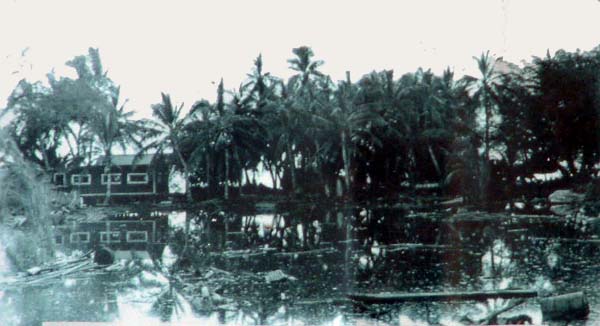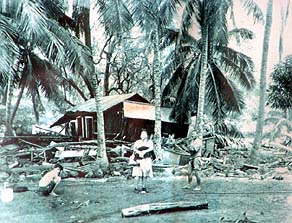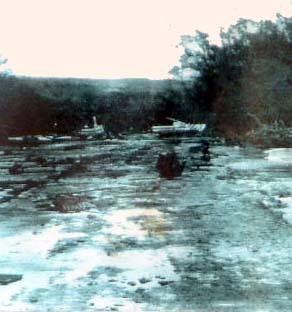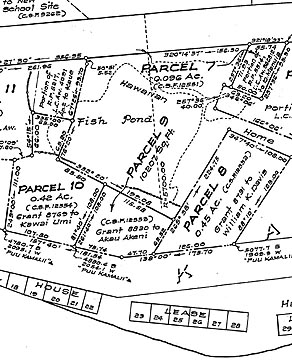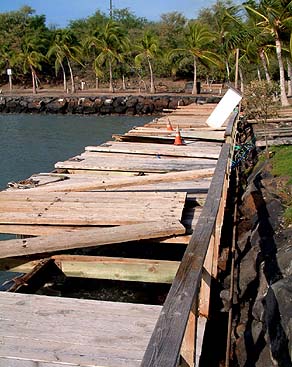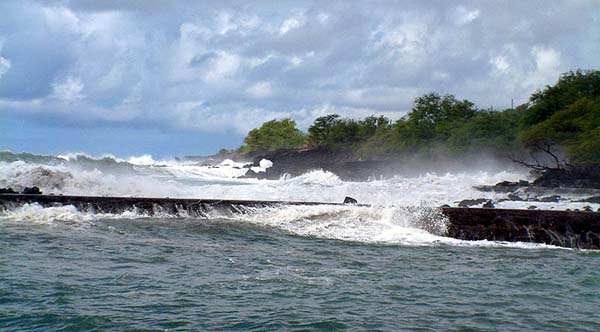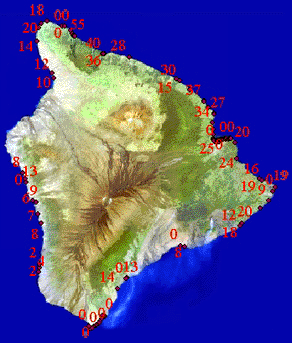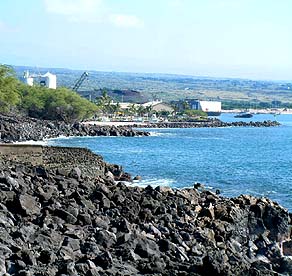 |
 |
 |
|||||
|
|
|||||||
|
|
|||||||
| |
|
|
|
“I was there when they had the first tidal wave in 1946,” ‘Ilima recounts. “My Dad was in Hilo. I remember my Mom that morning, she looked out from the window and she said ‘Something’s not right.’ The tide had just receded, gone way out, and you could see the coral that we never normally saw. So my Mom picked up her crab net and her little bucket and she said, ‘Well, I’ll go crabbing.’ "And as she was going out towards the beach she heard this rumbling, from the wave that was coming in. And our house was maybe four feet off the ground, I think, and it was one of the older houses. We were Christians, so my Mom kind of sensed something was wrong and so she grabbed us and we just got down and prayed."
|
||
|
|
||
"And the wave just went right under our house. But it took all the houses behind us, and they were newer houses. “I remember the fish all in our yard so we kind of ran out, and my Mom said ‘Don’t,’ because the wave went out and it started rumbling again. It’s not one of those 30 feet waves that you see that break. It just piles up and then it comes in. “And I remember people crying, and I remember an old Hawaiian lady was on the top of the coconut tree. The water had lifted her up and so she hung on and she never let go. In fact when they tried to get her off the tree, the wave had taken all of her clothes off too.” “When the tsunami came in, everything was wiped out,” Papa says. “That’s ’46. The ’46 the tidal wave bust ‘em up first, and then later on, another came in. But it wasn’t as bad as the ’46 one."
|
|
|
"The ’46 one, I was standing right here watching down. You could see the sampans on the beach. Then, ‘Hey, where’re all the sampan on the beach going?’ We ran down there, then when we see the thing coming, we took off up on this road here. "We came out at one point and watched, then we ran up here, watching from here. Then everything came in like that, swoosh. We just seen things moving. All the houses in the front, all gone. Yea, the pier—the old wharf—the land marks, gone. The cattle corral, one part is gone. My grandfather them, down below, it just turned them around.” “My grandparents—my dad’s parents—were living here on the beach,” says Ku‘ulei. “And my dad had gone to War. My grandmother, she said everything went in the water. All they did was run. And she had two small boys, so she said she’d just grabbed the kids and ran. My family didn’t get lost or anything in that tidal wave. Kawaihae was okay actually. They did better than most. Other places got worse. It’s just a lot of people were living on the beach; there was no defense."
|
|
|
|
|
| “1946, we came back right after the tsunami,” Pua remembers. “This place was a mess. Right next to where we lived down at the old Kawaihae we had this big open space and that’s where part of the wharf ended up. And out of all the homes that got wiped out by the tsunami, our home was the only house standing by itself. All the other homes got thrown in the back, and our house was the only house that stood firm. But that’s how come we got the big pond." “In the process of the wave coming in, it made a big pond,” ‘Ilima explains, “just behind our house. Because there was this hole and it just filled it up with water. It stayed there until they built what’s there now.”
|
||
| |
||
"And a certain time of the year that pond got tons of mullet," Pua remarks. "Where it came from, nobody knew. Certain time of the year those mullet would run in that big pond, and we used to catch them with bread. You put bread on the hook, and you stand, and you just hooked them one after another. And my Dad and Mom used to dry it, and send it to our son in Honolulu. My Mom was a good cook. “But this mullet that was in the pond, you had to put them in clean water because they got a lot of mud in them. So you had to let them swim and throw the water away, and you set up new water and let them go again. And so all the mud would come out. Because if you eat it like that, ugh." “There were fish in there,” ‘Ilima says, “there were mullets and such, but everybody would come and throw their trash in their and I mean, it was dangerous. We never could swim in there because there was a lot of rubbish and we weren’t sure if there was glass and cans. But we would hook the mullet, and we would make makeshift bridges and walk across and see who would fall in and I usually fell in.”
|
|
|
“The pond was there like forever!” Jeannine exclaims. “It was the stinkiest thing you ever smelled, because the water couldn’t escape. But then when the tide was high, you could see that the water level in the pond rose, and then when the tide receded, then the water level would drop. "When the tidal wave came, it knocked down all these gigantic kiawe trees. These stumps made different islands, and my Mom always told us, ‘Don’t you kids ever fall in that stink water, you’re going to get a beating if you do.’ “And of course at one time or another, one of us fell into the stink water, and it had so much green limu in it, and we would come out of the water, dripping of limu, and we’d always get a spanking because, ‘You guys are going to get sick if you fall in that water, it’s got all kinds of stuff in there.’ "But all the time, somebody would fall in there, because of the tidal wave, it had like furniture and chairs and all kinds of stuff. It was our greatest fear of falling into that stink pond, because we never knew what else was at the bottom. So we’d come out faster than we fell in!”
|
|
|
|
|
“The tidal wave came on April Fools Day, 1946,” Lala says. “Oh, it took practically everybody’s house out, except one house, was ours. Pretty new house too, it spun it around. Spun the house right around and drop it. Knocked out the stilts, we had to jack it back up again. Later we broke it down and made two houses. “The tidal wave started off on the old pier. It lifted up the whole pier, and it was coming toward the village over here, on the sand. It went up across the street, across the road. And the water came right up to here, and the whole pier, it picked it up. It picked up that pier, lifted it up and just came down like 40, 50 miles an hour. "It wiped out all the houses down there, except for our house. That thing just spun around and it just dropped and stayed there! We were right next to the fish pond. Nagasawas, they had a two story house, it ended up in the fish pond. We were lucky, it just spun ours around and hung on—a coconut tree held it. “Was I scared? Oh yeah! We just ran up. The boats, my dad’s boat got saved, it was in Pelekane. He was catching bait. We had no idea it was coming.”
|
||
| |
||
“The tsunami, I remember what my Mom told me about it," Jeannine says. "They were at home and somebody told my Grandma, ‘Look, the water is going out’ and all these fish, they could see the fish. So my Grandma knew right off the bat that it was a tidal wave. "And so my Grandma started stuffing a lot of things in pillow cases and would give one to my Mom and one each to my other aunts and uncle and told them, ‘run up to the mango farm.’ My Grandma made everyone run up there, with their little pillow cases full of their belongings.”
|
|
|
“In 1960, we weren’t still living in Kawaihae," ‘Ilima says, "but that was the one that devastated Hilo. A lot of people lost their lives in Hilo. The town was just demolished. It just came in and a lot of people died because they were told to leave, and the wave didn’t come and if it did it was just a small one, so people said, Ahh, so they went back to their houses and then the big one came. "I remember going to Hilo, because my Dad worked for the county, so all the county workers had to go into Hilo to clean up. And I remember the stench was so bad because there were dead bodies that were under the rubble. I don’t believe anybody lost their lives in Kawaihae, but in Hilo they did.”
|
|
|
|
“Where we still live," Ku‘ulei says, "if there’s a tidal wave, I don’t know how well we’d do. The coral flats would break it all down before it got here, but I’m sure we’d get wet.”
|
||
|
|
||
|
|
|
|
|
|

|
| Kawaihae Home | Map Library | Site Map | Hawaiian Islands Home | Pacific Worlds Home |
|
|
|
|
|
|
|||
| Copyright 2006 Pacific Worlds & Associates • Usage Policy • Webmaster |
|||
